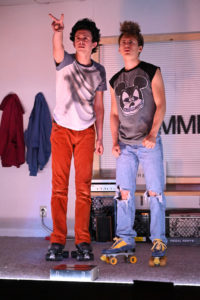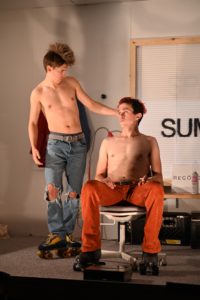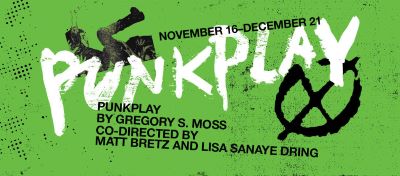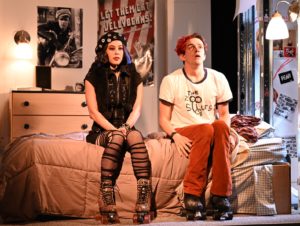PUNK’D
In many ways, Gregory S. Moss’s 1980s-themed punkplay feels like a dream. Props and seasons are generically labeled. Flights of fancy are realized like make-believe. Even the era itself is presented as a distant memory we’re not sure really happened. Unfortunately, the wistfulness of a nighttime enigma doesn’t always make for compelling storytelling. Co-directed by Matt Bretz and Lisa Sanaye Dring for its Southern California premiere by Circle X Theatre Co., punkplay is a half-baked vision that obfuscates more than illuminates its theme. Upon awakening, we’re not really sure what the point was.
The play opens on a promising note with a poetic ode to the ’˜80s. It’s specific enough to spark nostalgia and curiosity for what’s to come, yet abstract enough to allow room for interpretation. It ends similarly: coming-of-age “deepities” and vague platitudes that mean as much, or as little, as the audience brings to them. As for everything in-between, don’t expect much. A rather uneventful school year in the life of two high school boys is stretched thin; it’s up to playgoers to provide meaning.
 Under his father’s threat of military school, wayward teen Duck (Dempsey Bryk) moves in with his fellow punk-obsessed classmate Mickey (Zackary Stone Gearing). These angsty hornballs are as naive about life as they’re committed to giving society the bird. They spend their days jamming to punk, evading bullies, awakening to burgeoning sexualities, and conforming to anti-conformism.
Under his father’s threat of military school, wayward teen Duck (Dempsey Bryk) moves in with his fellow punk-obsessed classmate Mickey (Zackary Stone Gearing). These angsty hornballs are as naive about life as they’re committed to giving society the bird. They spend their days jamming to punk, evading bullies, awakening to burgeoning sexualities, and conforming to anti-conformism.
For such a singularly focused title, punkplay’s perspective of the punk world is confined to a lone bedroom of two outcasts whose troubles and life experiences are relatively unimpressive or suggestive of much rage. It could be argued they’re merely poseurs. One of the play’s running themes is who or what’s considered punk and who gets to decide. Because the play posits such questions, it opens itself up to similar critique: how authentically punk – or at least knowledgeable – is it? Regardless of how one answers that question, the depths of which it explores its subject matter is superficial. Characters are as paper-thin as the walls they punch through; supporting characters come and go without clear purpose or impact. Similarly, any semblance of a plot is negligible, making way for “slice of life” moments that merely tread water.
 The show is in many ways as adolescent as its protagonists. Both the script and direction forgo nuance to paint teenage rebellion in broad strokes. Rampant cursing and shouting don’t reveal what, if anything, is below the surface. Such superficial aggression might work for three-minute punk songs filling a mixtape, but a full-length play about such misfits needs more subtlety and motivation. On the b-side, a lack of maturity is a breeding ground for unconventional playfulness that’s one of the work’s strong suits. A great design team (Sibyl Wickersheimer, set; Adam Lawrence, puppets; Nichole Baffone, props; Jeff Gardner, sound; and Dustin Hughes, video) band together to create a world fit for fighting, thrashing, and releasing. Specific effects are clever and comical. Likewise, Ann Closs-Farley’s costumes replicate ’˜80s punk styles believably. Some of the (uncredited) wigs and hairpieces, however, are obvious, cheapening the overall look. Rob Cairns’ and Beth Thornley’s punk songs are appropriately amateurish, but give Mickey and Duck an outlet to vent (even if their garage band desires are greater than their talents).
The show is in many ways as adolescent as its protagonists. Both the script and direction forgo nuance to paint teenage rebellion in broad strokes. Rampant cursing and shouting don’t reveal what, if anything, is below the surface. Such superficial aggression might work for three-minute punk songs filling a mixtape, but a full-length play about such misfits needs more subtlety and motivation. On the b-side, a lack of maturity is a breeding ground for unconventional playfulness that’s one of the work’s strong suits. A great design team (Sibyl Wickersheimer, set; Adam Lawrence, puppets; Nichole Baffone, props; Jeff Gardner, sound; and Dustin Hughes, video) band together to create a world fit for fighting, thrashing, and releasing. Specific effects are clever and comical. Likewise, Ann Closs-Farley’s costumes replicate ’˜80s punk styles believably. Some of the (uncredited) wigs and hairpieces, however, are obvious, cheapening the overall look. Rob Cairns’ and Beth Thornley’s punk songs are appropriately amateurish, but give Mickey and Duck an outlet to vent (even if their garage band desires are greater than their talents).
 As the two leading players, rollerskates-clad Gearing and Bryk rink around their character demands with youthful sex appeal. While their roles are written with a naiveté and inexperience that defies believability for near-graduates, the actors play down to such roles rather than inhabit them honestly. Bryk trips over his lines repeatedly. As a supporting player, Mathew Dunlop goes from uncomfortable caricature to just shy of convincing in his two respective roles – the first being as unnecessary as the cartoonish accent he brings to it. Sadie Kuwano, however, brings specificity to her multiple characters, transforming seamlessly in ways that are unique and grounded in contextual reality.
As the two leading players, rollerskates-clad Gearing and Bryk rink around their character demands with youthful sex appeal. While their roles are written with a naiveté and inexperience that defies believability for near-graduates, the actors play down to such roles rather than inhabit them honestly. Bryk trips over his lines repeatedly. As a supporting player, Mathew Dunlop goes from uncomfortable caricature to just shy of convincing in his two respective roles – the first being as unnecessary as the cartoonish accent he brings to it. Sadie Kuwano, however, brings specificity to her multiple characters, transforming seamlessly in ways that are unique and grounded in contextual reality.
If punkplay is punk, it’s in its unvarnished delivery and eschewing of traditional story demands — as if to say “bugger off, wanker.” While it has a lot to get off its chest, it yells into the mic before it’s clear what it wants to say. For instance, hints of gay sexual repression between the frequently shirtless friends are alluded to without payoff (gaybait first, resolve never). Such untied strings are common throughout. In many ways the work is a lost youth without any clear direction or purpose. It can’t decide whether it wants to damn the man, do the man, or be the man. But in order for us to make sense of its world, it needs to offer more than vague concepts with no clear reasons to care – or what’s the meaning of it all?
Now there’s something to rage against.
photos by Gary Leonard
punkplay
Circle X Theatre Company
Atwater Village Theatre, 3269 Casitas Ave.
Thurs & Fri at 8; Sat and Sun at 7
ends on December 21, 2019
for tickets, visit Circle X




